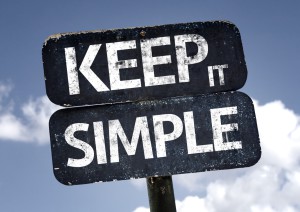Use the MVP Concept to Make Your Communications More Concise
 In a conversation I had recently with one of my coaching clients, she asked me how to handle a request from a senior level executive for a report on a particular topic. Although she had an idea why he needed the information, she was not exactly sure, and for various reasons was not in a position to probe further for clarification. She was in a quandary: how much should she pack into her response. Her question for me was, is it better to cover all possible contingencies to ensure he got what he needed, or to focus on her own guess?
In a conversation I had recently with one of my coaching clients, she asked me how to handle a request from a senior level executive for a report on a particular topic. Although she had an idea why he needed the information, she was not exactly sure, and for various reasons was not in a position to probe further for clarification. She was in a quandary: how much should she pack into her response. Her question for me was, is it better to cover all possible contingencies to ensure he got what he needed, or to focus on her own guess?
I’ve fielded this question in various ways many times in the past, because it’s a common issue I see when experts interact with generalists. I’ve also heard many times form the generalist side, those at senior levels who need information to make informed decisions or recommendations higher up their own chain of command. Typically, their complaint is that when they ask someone what time it is, they’re given a tutorial on watchmaking. In general, they prefer less rather than more; if they need more they will ask for it.
On the other hand, those providing the information, because they know so much about the topic, hesitate to give a simple yes or no because they see so many shades of grey. More selfishly, they are afraid of being caught short by not giving the questioner what they need, or they think they can bolster their own credibility by showing off their command of a difficult and nuanced topic. So, they give more rather than less, and expect the recipient to glean what they need from the mass of information. Recipients may not have the time or inclination to dig through it for what they need, and the consequence is inefficient and ineffective communication, which helps neither party.
Because she works in software development, I asked her if she was familiar with the concept of a minimum viable product, and she instantly caught on to what I was proposing. Basically, an MVP is a way of getting to market quickly with a product that works, that just does what it’s supposed to do, rather than delaying launch to pack in features to try to please everyone. In effect, an MVP is a best-guess hypothesis about what the market needs. It’s not a stab in the dark, because it’s based on your knowledge of the “customer” and your analysis of the situation.
Give them what you think they need. Answer their question directly without hedges, caveats and circumlocutions. Most of the time, you will give them exactly what they need, but if they need more, they will ask for it. The payoff for them is time and clarity; they won’t have to wade through a swamp of excessive detail to get exactly what they need.
The payoff for you is time and credibility. Make this a habit, and others will find that you are a clear, prompt and credible source of the information and judgment—and that will make you a different sort of MVP!




